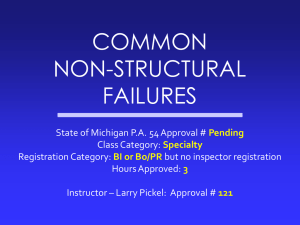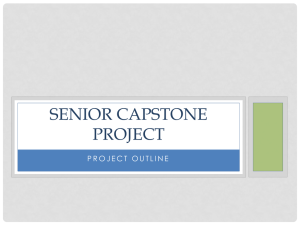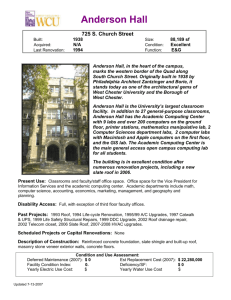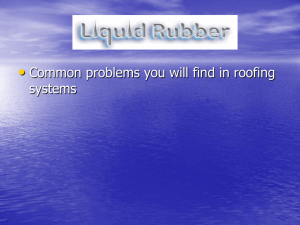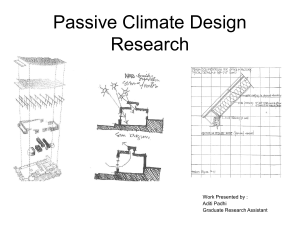DocX Version - General Roofing Systems Canada
advertisement
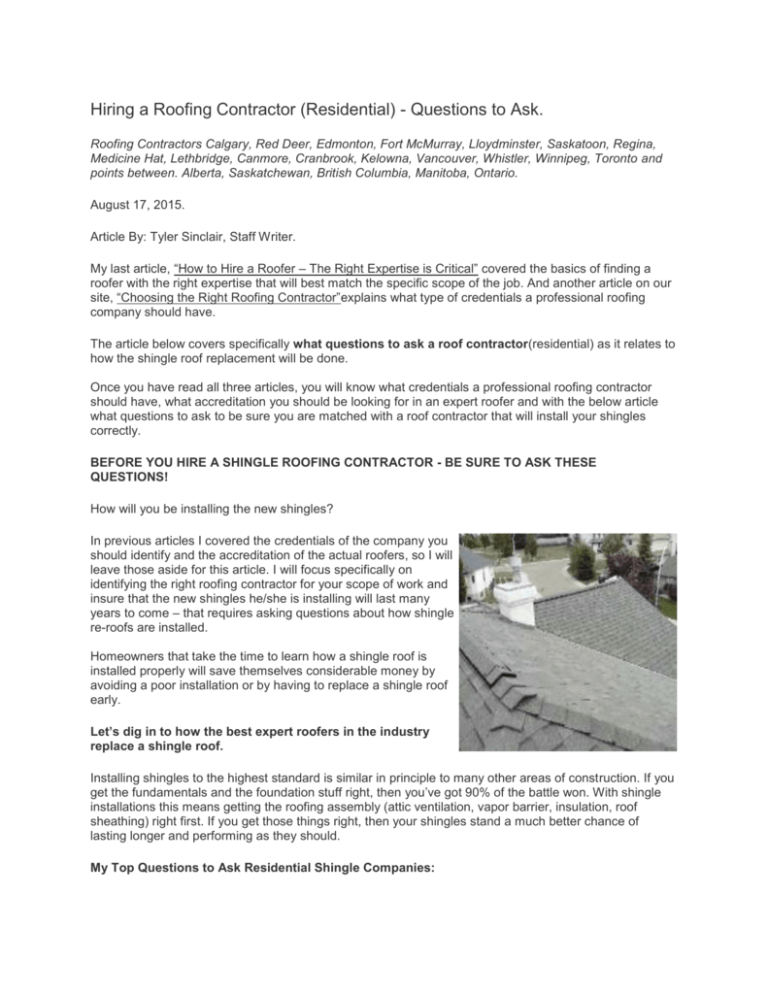
Hiring a Roofing Contractor (Residential) - Questions to Ask. Roofing Contractors Calgary, Red Deer, Edmonton, Fort McMurray, Lloydminster, Saskatoon, Regina, Medicine Hat, Lethbridge, Canmore, Cranbrook, Kelowna, Vancouver, Whistler, Winnipeg, Toronto and points between. Alberta, Saskatchewan, British Columbia, Manitoba, Ontario. August 17, 2015. Article By: Tyler Sinclair, Staff Writer. My last article, “How to Hire a Roofer – The Right Expertise is Critical” covered the basics of finding a roofer with the right expertise that will best match the specific scope of the job. And another article on our site, “Choosing the Right Roofing Contractor”explains what type of credentials a professional roofing company should have. The article below covers specifically what questions to ask a roof contractor(residential) as it relates to how the shingle roof replacement will be done. Once you have read all three articles, you will know what credentials a professional roofing contractor should have, what accreditation you should be looking for in an expert roofer and with the below article what questions to ask to be sure you are matched with a roof contractor that will install your shingles correctly. BEFORE YOU HIRE A SHINGLE ROOFING CONTRACTOR - BE SURE TO ASK THESE QUESTIONS! How will you be installing the new shingles? In previous articles I covered the credentials of the company you should identify and the accreditation of the actual roofers, so I will leave those aside for this article. I will focus specifically on identifying the right roofing contractor for your scope of work and insure that the new shingles he/she is installing will last many years to come – that requires asking questions about how shingle re-roofs are installed. Homeowners that take the time to learn how a shingle roof is installed properly will save themselves considerable money by avoiding a poor installation or by having to replace a shingle roof early. Let’s dig in to how the best expert roofers in the industry replace a shingle roof. Installing shingles to the highest standard is similar in principle to many other areas of construction. If you get the fundamentals and the foundation stuff right, then you’ve got 90% of the battle won. With shingle installations this means getting the roofing assembly (attic ventilation, vapor barrier, insulation, roof sheathing) right first. If you get those things right, then your shingles stand a much better chance of lasting longer and performing as they should. My Top Questions to Ask Residential Shingle Companies: Attic Ventilation. Question: Before you start work, do you do an analysis of my roof attic ventilation? Answer: The correct answer to whether you should have your attic inspected for proper ventilation is yes. Question: If you do inspect my attic, why is this important? And if so, what are your objectives? Answer(s): An inspection of the attic ventilationis important for the following reasons: Shingle Life-Span. Attic ventilation is the number one determining factor (assuming the shingles were installed correctly) of your roof’s life-cycle. In other words, if you do not have enough attic ventilation, the sun will cook the shingles faster, which lowers the life span of your shingles. Proper ventilation will cool your attic in hot summer months. Ice Dams and Condensation. Proper attic ventilation will go a long way to solving manyice dam and condensation problems homeowners face. When warm air enters the attic from the inside of your home it is important for that warm air to vacate the attic efficiently and at the correct rate. Question: What exactly will you be inspecting, how will you be inspecting each area, and why? Answer: I will be inspecting the intake air at the soffits or at the vertical wall of your attic. I will also be inspecting the exhaust air at the ridge (static vents, ridge vents, whirly-birds etc). I will also be inspecting your vapour barrier, insulation, and roof deck (sheathing). The reason I will be inspecting the air intake at the soffits is that cold air comes in at the soffits. Cold air intake at the soffits is critical for ensuring hot air is released (lifted) to the exhaust vents at the ridge. I will ensure that you have adequate soffit intake and I will also ensure that no insulation or other obtrusions are covering the intake air flow at the soffits. The reason I will be inspecting the vapour barrier is because a properly sealed vapour barrier is critical to ensuring that warm air does not escape from your house in to your attic space. This warm air will cause condensation and ice dams in the winter. The reason I will be inspecting the ridge exhaust venting is that your attic needs one square foot of exhaust venting for every 100 – 300 square feet of attic. If the hot air cannot escape the attic your shingles can bake (especially the south facing shingles) causing them to have up to half the life cycle of a shingle roof installed on a healthy roof and attic assembly. I will also ensure that the exhaust ventilation is not working against itself – in other words, there exists the possibility that incorrect vent combinations have been installed. For example, a whirly-bird vent cannot be installed between to static vents. The reason for the inspection of your insulation is that wet insulation is a sign of either roof leaks or condensation. This information goes a long way in assisting me when designing and installing your new roof vents. It is also important to identify insulation that has been soaked because it now holds no R Value and those areas of insulation should be replaced. The reason I am inspecting the roof sheathing (roof deck) is because I need to know if I will need to replace any rotted sheathing. I will also need to know (for ventilation design) whether your attic has been “sweating” or if there is any evidence of condensation or frost. Preparation of the Roof Deck (sheathing) Question: When you remove the old shingles, do you remove all the old nails or hammer them in to the roof deck? Answer: The right way to re-roof shingles is to remove all the old shingles nails. If you hammer down the old nails you risk the chance of them working their way back out and damaging your new shingles. Question: When you remove the shingles and you locate “roof rot”, do you replace the sheathing? If so, specifically how do you perform this work? And if so, what will you charge? Answer: Whenever rotting of roof sheathing is located it has to be replaced. The correct way to do this is to be sure that sheathing is replaced from truss to truss – in other words, small pieces won’t be “stubbed” in that aren’t connected and nailed to at least one truss on either side of the sheathing. It is also important that proper nails are used (for sheathing installation work). It is important that regular shingle nail guns are not used with standard roofing shingle coil nails. Shingle coil nails will not firmly hold sheathing in place and the sheathing will eventually buckle. When the sheathing “buckles” it will be easily noticed at street level. Waterproofing Underlayment Waterproofing underlay is to be installed to the roof sheathing prior to the shingle installation. What type of underlay, how it is installed, where it is installed and if it is installed at all are all important. Question: Do you install roof underlay? If so, what type? Tar paper, ice and water or synthetic? Answer: Roof underlay is critical for sound waterproofing. If the roof is less than a 4:12 pitch then ice and water underlay is best to the complete roof deck. For roofs 4:12 or greater a high quality ice and water peel and stick underlay is appropriate for the eaves (44”), in the valleys and at penetrations. Tar paper gets brittle over time and shouldn’t be used at all with modern technology now available. For the field area of the roof a synthetic breathable underlay is best. Question: Specific to underlay, do you install ice and water at the eaves and if so how far up the eaves? Do you install ice and water at the valleys, and if so, do you also install any after valley metal is installed at the edges of the valley metal? Answer: Ice and water underlay (peel and stick) should be at the eaves, in valleys, behind and on sides of penetrations etc. The highest specification for open valleys is to install the ice and water vertically in the valley, install the metal and then install ice and water to both sides of the valley metal. This makes the valley area waterproofing monolithic in nature and will not allow ice dams to get in and under the valley metal causing roof leaks. Question: Specific to underlay, do you install ice and water at the back and /or sides of roof penetrations such as chimney flashing, skylight flashing, rooftop vents and pipe boots? Answer: Every roof penetration should be “wrapped” with ice and water peel and stick underlay to avoid ice working its way up and under the backside of roof vents and pipe boot flanges, in to skylight flashing and chimney flashing areas. The process involves installing peel and stick to the back and sides of all penetrations and flanges. Question: Specific to underlay, do you install it right to the peak and at hips and overlapping or do you cut it short? Answer: Roof underlay should be “wrapped” at ridges and hip connections. The reason you do not want to cut your underlay short is simple, if you experience a shingle blow-off then no part of the roof sheathing (deck) is exposed to the rain or storm elements. Shingle Nailing: Storm Nailing and Nailing Patterns. Question: Do you storm nail as standard policy? How many nails per shingle do you use and what is the pattern? Answer: We storm nail all shingles on all roof systems all the time. The reason for this is that the difference between four nails and six nails is an extra second per shingle. Storm nailing will insure that when winds are high that the shingles will not blow off. The pattern for nailing for all shingles is expressly described on the shingle package. Typically the shingle nails have to be placed within the nailing zone and the two outside nails (placement of) are very critical (to avoid blow offs). Metal Flashing. Roof Drip Edge, Valley, Chimney and Skylight Flashing Question: Do you install eave edge (drip edge) flashing at the eave area of the roof sheathing? Do you replace required flashing at the chimney and skylights? Do you install valley flashing? Answer: Yes, we do install eave edge flashing – it is critical for proper waterproofing and run off of water. The drip edge allows water to enter the gutters (eaves-trough) properly. It also acts to protect against ice damming. When ice dams build up in the gutter and begin to build up on the roof they tend to work their way under shingles. If you have proper drip edge installed and ice and water membrane at the eave installed to the sheathing, this will go a long way to keeping your roof edge leak free when the ice dams melt. Question: Do you attempt to color match the roof flashing to the new shingles? Answer: Yes, a new shingle roof looks much better if the roof flashing is matched to the new shingle color. Roof Accessories. Static Vents, Whirly-Birds, Pipe Boots and more Question: Do you replace all static vents, whirly-birds, pipe boots etc. with new accessories? Answer: Yes, all roof vents, penetrations and accessories are replaced when your shingles are replaced to insure all components of your roof are both fully under the warranty of the manufacturer and also to be sure they will last as long as the shingles. Shingle “Off-set” Installation Question: When you install the shingles, do you place the shingles specifically in the pattern (off-set) as prescribed by the shingle manufacturer? Answer: Yes, all shingle manufacturers have a prescribed “off-set” pattern required when installing shingles. The reason this is important is for “water-shedding”. The engineering of the shingles and the subsequent pattern of install is critical to insure a leak free roof system when it is complete. Also, it is important to follow the pattern of install perfectly as it is a requirement of the manufacturer’s warranty. Pricing Question: Are all the particulars of installation as discussed above in points 1 – 7 included in your quotation? Answer: Yes, all items discussed are included as a turn-key shingle installation price and no extras will surface and surprise you. Our quotations are detailed and you will be provided an itemized work order for your execution explaining everything included in your roof replacement before we commence work. Winter Installation Question: Do you install shingles in the winter? If so, what special procedures do you use when installing in the winter. Answer: We do install shingles in the winter. However, shingle manufacturers have guidelines for winter installation that may affect your warranty. An example is the temperature at which the shingles were installed, it is important to be sure the guidelines of the shingle manufacturer are followed. Also, shingle installation in the winter will require extra tar dabbing of the shingles (in accordance to the shingle manufacturer directions). Professionalism. Conduct. Clean-Up. Accreditation. Insurance. Workmanship Guarantee. Better Business Bureau. For more information on the professionalism you can expect from the crews at General Roofing Systems Canada (GRS), please visit our roof shingle replacement guide for homeowners. Other online resources: Infrastructure Health and Safety in Ontario offers this brochure (pdf) as a guider to hiring roofing contractors. http://www.ihsa.ca/pdfs/products/IHSA023-Hiring-a-Roofing-Contractor-Tips-forHomeowners.pdf CONTACT US: General Roofing Systems Canada (GRS) 24 Hour Emergency Roof Repair: Call +1.877.497.3528 toll-free. info@grscanadainc.com | www.grscanadainc.com Roofing Contractors Calgary, Red Deer, Edmonton, Fort McMurray, Lloydminster, Saskatoon, Regina, Medicine Hat, Lethbridge, Canmore, Banff, Cranbrook, Kelowna, Vancouver, Whistler, Winnipeg, Toronto and points between. British Columbia. Alberta. Saskatchewan. Manitoba. Ontario. Article Topics: How to Hire a Roofing Contractor.



